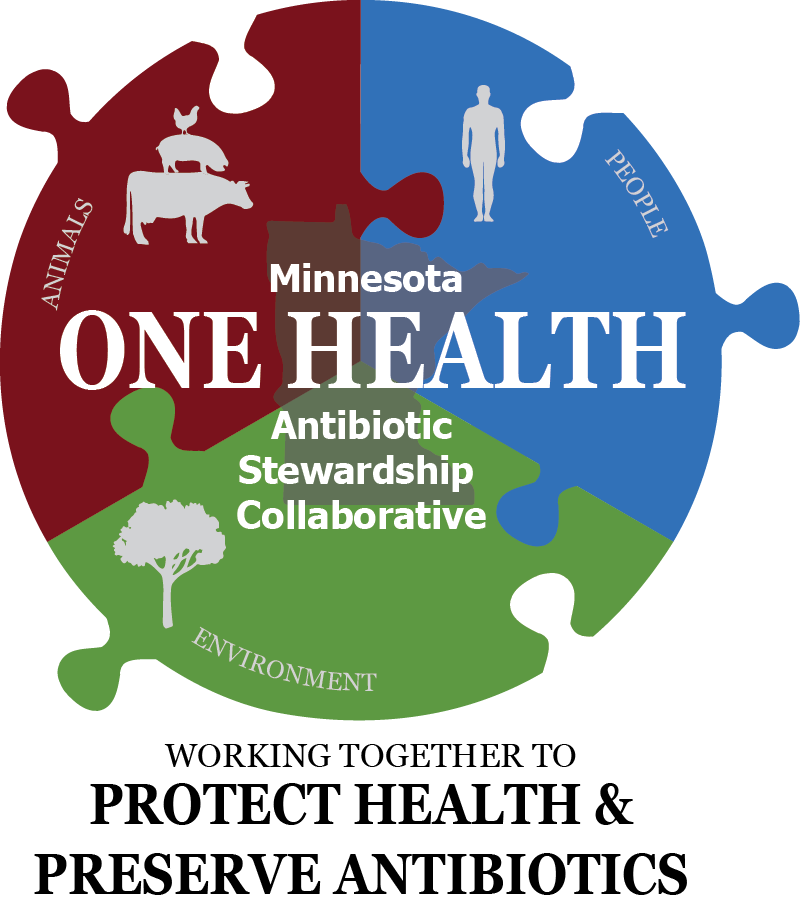Minnesota Department of Health MN Antibiotic Stewardship Collaborative Update Bulletin
Minnesota Department of Health sent this bulletin at 01/17/2017 09:59 AM CST |
Updates and News Alerts from the Minnesota One Health Antibiotic Stewardship Collaborative |
Stewardship quiz? You betcha! (scroll down for answer)
Biosecurity is the term for collective measures taken to prevent the spread of infectious diseases into and among livestock populations. Infection prevention and control (IPC) is the term for measures to prevent transmission of infectious diseases to and among patients in human and veterinary health care settings.
What do the practices of IPC and biosecurity have to do with antibiotic resistance and stewardship?
a. Preventing people and animals from getting sick means we use less antibiotics.
b. IPC and biosecurity help limit spread of resistance genes among bacteria in human and veterinary medical settings and on farms.
c. Biosecurity measures prevent transmission of resistant bacteria and/or resistance genes between humans and animals.
d. All of the above
Update from Your Minnesota Stewardship Collaborative
Meeting of Technical Work Groups for Minnesota One Health Antibiotic Stewardship Collaborative a Success
Achievement of the Minnesota One Health Antibiotic Stewardship Five-Year Strategic Plan objectives can only be carried out through the collaborative efforts of dedicated statewide stakeholders. On December 9, 2016, members of all four Technical Work Groups, aligned with the four major Strategic Plan goals, came together for an annual working meeting. At this meeting, work group members learned about updates in stewardship science and regulations in human, animal, and environmental health. They also continued to make progress toward achievement of strategic plan goals, outlining progress to date and next steps. Notes from the meeting can be accessed on the One Health Antibiotic Stewardship website.
One Health Antibiotic Stewardship Collaborative Highlighted in CIDRAP Podcast
The Center for Infectious Disease Research and Policy interviewed One Health Antibiotic Stewardship Director Amanda Beaudoin about the stewardship collaborative and statewide activities to promote stewardship in human, animal, and environmental health. Listen to all CIDRAP stewardship podcasts here.
News to Note
With the New Year Comes New Antibiotic-Related Requirements from FDA and Joint Commission.
- Effective January 1, 2017, are new, more stringent, rules from the federal Food and Drug Administration, guiding how medically important antibiotics can be administered to animals in feed and drinking water. Read AVMA's summary of the new rules.
- Joint Commission, the body responsible for accrediting many U.S. hospitals, has made mandatory a new standard for antibiotic stewardship. Read the Joint Commission Antibiotic Stewardship Standard.
CDC Releases State-by-State Fact Sheets to Show Funding for Work to Combat Antibiotic Resistance.
- Ever wonder how CDC invests in combatting antibiotic resistance? Look to see how CDC funding is used in your state.
Dispatch Describes Increasing Antibiotic Resistance in Shigella spp. from Infected New York City Residents.
- This Emerging Infectious Diseases article describes findings from public health laboratories in New York City, conducting susceptibility testing of Shigella isolates.
- Approximately 20% of Shigella isolates tested during 2013–2015 showed decreased susceptibility to azithromycin.
- Patients with azithromycin-resistant infections were older and more likely to be male and infected with HIV than patients with susceptible infection, and 85% self-identified as men who have sex with men.
- These findings highlight a need for guidelines of clinical interpretation of azithromycin susceptibility testing results.
In Chinese study, 15% of Salmonella Isolates from Slaughter-House Pigs Harbored mcr-1 Resistance Gene.
- The mcr-1 gene, which imparts resistance to the last-resort antibiotic colistin, was identified in 15% of Salmonella isolates obtained from pig cecal specimens collected at slaughter houses in southern and central China.
- Authors of this Emerging Infectious Diseases article found that mcr-1 was associated with plasmids, genetic elements that allow the transfer of resistance among bacteria.
- Plasmid-mediated resistance is a major threat and necessitates vigilant surveillance and measures to prevent transmission of resistant bacteria and resistance elements among animals and humans.
Upcoming Events
Minnesota Antibiotic Stewardship Conference
- March 15, 2017; 8am-4:30pm; Saint Paul, MN
-
Focus will be on antibiotic stewardship in long-term care settings
Minnesota Veterinary Medical Association Annual Meeting
- February 23-25, 2017; Minneapolis, MN
Quiz Answer!
Correct Answer: d. All of the above
IPC and biosecurity are essential to the overall strategy to combat antibiotic resistance, preventing infections and limiting opportunities for resistance to develop and spread. Many IPC practices in health care settings (human and veterinary) are actually similar to biosecurity measures used on the farm. Key to both is having established facility protocols and a system for disease surveillance.
IPC in medical settings prevents infection transmission among patients, contamination of shared equipment and surfaces, and transmission of infections to or from health care workers. Some key IPC measures include hand hygiene, environmental cleaning and disinfection, safe use of needles, use of masks, gowns, and gloves, separating contagious patients or patients with resistant infections, vaccinating workers, and encouraging workers to stay home when ill.
Biosecurity in animal agriculture keeps infectious diseases, including those caused by bacteria and viruses, off farms, out of barns, and out of individual herds. Some components of biosecurity include limiting visitors, hand hygiene, changing boots and clothing when moving among farms or barns, placing disinfectant "footbaths" at doorways, environmental cleaning and disinfection, preventing entry of wild birds and rodents, vaccinating livestock, encouraging workers to stay home when ill, and vaccinating employees against diseases like influenza, which can pass between people and some animals.
Even outside of health care and farm settings, CDC tells us we can all practice infection prevention. We can avoid many infections and illnesses, especially viral infections in the winter, through hand washing, and food safety measures can prevent gastrointestinal infections caused by bacteria on meat and vegetable products. Preventing infections means less need for antibiotics.
Learn more about IPC on CDC's website.
Learn more about biosecurity for poultry on USDA's website.
Handy Links
Minnesota One Health Collaborative
CIDRAP: Antimicrobial Stewardship
USDA: Antimicrobial Resistance
Having trouble viewing this email? View it as a Web page.
